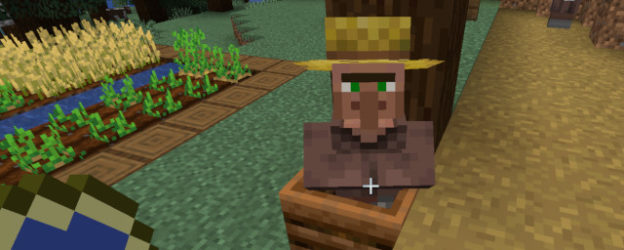The latest Minecraft update, “Village and Pillage,” has completely revamped villager professions and trading, and made major changes to the village structures as well. Each profession now has a work site defined by a block like a stone cutter, or a loom, or a composter, etc. and unemployed villagers will try to fill jobs based on what’s available.
Now, Minecraft has always been (in my experience, anyway) pretty good about upgrading existing worlds as the game engine changes.
- Unexplored areas will generate using new rules.
- Previously explored areas will remain the same, except…
- Specific blocks will convert as needed (ex: if you built a generic wooden fence before they introduced fences for each type of wood, it will convert to an oak fence.)
- All areas will start operating on new rules.
Normally this works great! But can you see the problem with villages?
Yeah. The villagers operate on the new rules, which means they need work sites to do their jobs, but the existing villages were built without any workstations.
So the village near my current base suffered an economic collapse, or perhaps an attack of existential mass ennui, leaving every villager unemployed.
Fortunately, all the new workstations are craftable. Even the ones that the player can’t use yet. So I spent some time on the wiki, writing down the ingredients I needed, went back to my base, crafted all of the ones I could, and started placing them around the village.
And it worked! Pretty soon I was able to trade with a farmer, librarian, fisherman, butcher, cartographer, etc. I’m still waiting for some of the unemployed villagers to pick up jobs. Maybe they need to actually walk close enough to the job sites or something?
Anyway, here’s the list of ingredients I put together based on the wiki article on villagers. You can get the crafting recipes from the wiki or in the game from the recipe book:
Minecraft Villager Job sites
| Job Site Block | Profession | Ingredients |
|---|---|---|
| Blast furnace | Armorer | 5 iron ingots, 1 furnace, 3 smooth stone |
| Smoker | Butcher | 4 logs, 1 furnace |
| Cartography Table | Cartographer | 2 paper, 4 planks |
| Brewing Stand | Cleric | 1 blaze rod, 3 cobblestone |
| Composter | Farmer | 4 fences, 3 planks (Java) or 7 planks (Bedrock) |
| Barrel | Fisherman | 2 wooden slabs, 6 planks (Java) or 2 wooden slabs, 6 sticks (Bedrock) |
| Fletching Table | Fletcher | 2 Flint, 4 planks |
| Cauldron | Leatherworker | 7 iron ingots |
| Lectern | Librarian | 4 wooden slabs, 1 bookshelf |
| Stonecutter | Mason | 1 iron ingot, 3 stone |
| Loom | Shepherd | 2 string, 2 planks |
| Smithing Table | Toolsmith | 2 iron ingots, 4 planks |
| Grindstone | Weaponsmith | 1 stick, 1 stone slab, 2 planks |
(Yes, a few of these are actually different in Bedrock Edition and Java Edition! I don’t know why Mojang would deliberately introduce differences in something as basic as crafting recipes, but apparently they have.)
Depending on how you play the game, you may never need to do this. If you generate new worlds all the time, or if you’re happy to just pull up stakes and move to a new area in the same world, you’ll encounter the updated villages to start with. But if you play like I do – explore the same world slowly, digging in, building up and establishing bases as I go – you’ll be glad to know that this works to manually upgrade your villages.


 I learned three nice things about the Kindle movie tie-in edition of Les Misérables today:
I learned three nice things about the Kindle movie tie-in edition of Les Misérables today: